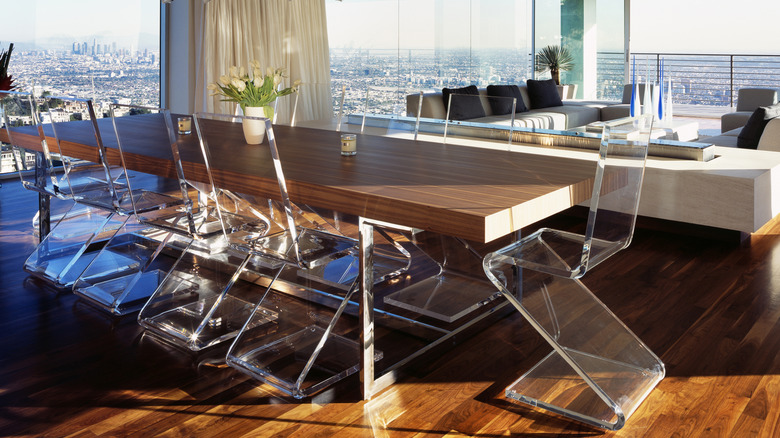The Interior Design Trend HGTV's Jeremiah Brent Avoids At All Costs
Home design trends come and go, and while some styles have timeless appeal, others are best left in the past. So, how can you tell when a trend is worth trying out and when it should be avoided? Before taking the risk to invest in a furniture fad, see what the professionals are saying about it. Interior designers are constantly working with new and traditional designs and have a better insight into what trends are made to last. That's why, when expert interior designer Jeremiah Brent shared the styles he would never buy in a TikTok clip, it had us rethinking every trend — especially acrylic furniture.
Brent's denouncement of the acrylic furniture trend wasn't just about individual taste. His critiques of the popular style were more practical rather than personal. There are plenty of retro design trends that are making a comeback in 2025, attracting homeowners to postmodern pieces like acrylic furniture for their colorful, vintage aesthetic. Before buying into this style, you might want to hear why Brent steers clear of it — and explore some more functional alternatives instead.
The messy drawbacks of acrylic furniture
In a TikTok video about design styles he would never buy, Jeremiah Brent gave his controversial take on acrylic furniture, saying, "For me, it's always dirty. It scratches within two seconds ... and it's just not smudge-proof. So, with kids and me, no thank you." Brent's criticism offers valuable insight. While acrylic may be stylish, it's also highly prone to visible messes and damage. Acrylic surfaces scratch easily from daily use and abrasive cleaners, requiring extra care to avoid damage — which isn't always as easy as it sounds.
Aside from scratches, acrylic shows dust easily and develops smudges and fingerprints quickly. Even if you've just cleaned your acrylic dining chair, something as simple as pulling it out to take a seat can leave you with more smudges. To keep these styles in good shape, you'll need to know the best ways to clean acrylic furniture and practice them regularly. Harsh chemicals, like ammonia-based cleaners, may remove smudges but can also cause the material to turn cloudy — which you won't be able to reverse. For busy households, the constant upkeep and delicate care can make acrylic furniture more frustrating than functional. If you love the sleek look of acrylic but don't want to deal with the hassle, there are some stylish alternatives that offer the best of both worlds.
The best alternatives to acrylic furniture
When looking for alternatives to acrylic furniture, it all comes down to materials. Many people love acrylic for its transparent look, making it a great design hack to visually declutter crowded rooms without sacrificing furniture. However, you can still achieve that sleek, retro aesthetic with fewer downsides by choosing alternative materials. One popular option is Lucite, and while technically it is a type of acrylic, it's stronger in durability, resistant to scratches, and easier to clean. If low maintenance is your priority, polycarbonate furniture is another great alternative. It mimics acrylic's clear appearance but has a higher strength, making it less vulnerable to certain chemicals — though it can still be prone to scratches.
If transparency isn't a must, metal furniture can offer a similar postmodern style with far less upkeep. Sleek metal coffee tables, shelves, and chairs provide a bold, eclectic look while being resistant to scratches, smudges, and damage from harsh cleaning products. Though the material lacks acrylic's transparency, its durability and longevity make it a more practical option. Acrylic fans may be disappointed by Jeremiah Brent's critique of the style, but his reasoning offers some real concerns worth considering — especially if a better alternative could leave you more satisfied in the long run.

